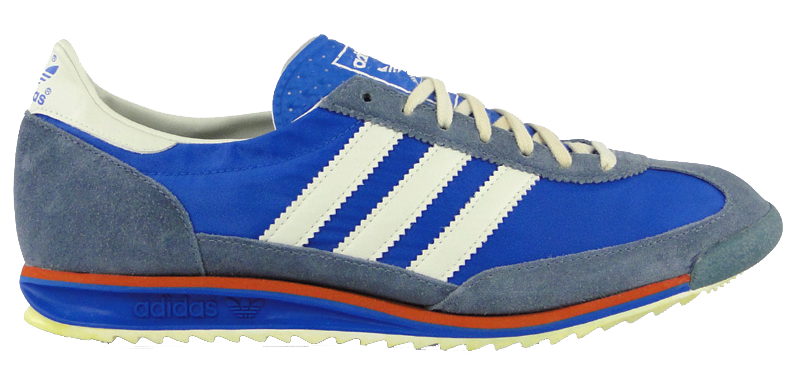With this projects I wanted to show the power of color on products. The iconic footwear pieces are easily recognized even if they are blocked down by color to a minimum. The significant attributes of each model which creates the unique look are enough.
I hope you enjoy the small journey through Adidas history!
STAN SMITH
Year Introduced: 1965
It didn't start as the Stan Smith. adidas' first leather tennis shoe debuted in 1965 as the Robert Haillet, named after a French pro. It wasn't until 1971 that Smith's name was added - and it wasn't until 1978 that Haillet's name was taken off, resulting in an odd, seven-year split signature. Smith won his last titles in 1980, but the sneaker that bears his name is still as popular as ever, proving once again that sometimes simpler is better. It also had a revival in 2014.
It didn't start as the Stan Smith. adidas' first leather tennis shoe debuted in 1965 as the Robert Haillet, named after a French pro. It wasn't until 1971 that Smith's name was added - and it wasn't until 1978 that Haillet's name was taken off, resulting in an odd, seven-year split signature. Smith won his last titles in 1980, but the sneaker that bears his name is still as popular as ever, proving once again that sometimes simpler is better. It also had a revival in 2014.


SUPERSTAR
Year Introduced: 1969
When you hear "adidas," you probably think "Superstar." The low-cut version of the second-generation shelltoe Pro Model, the Superstar gained traction in the NBA before being adopted by b-boys and spread worldwide by Run-DMC. And 40-plus years after its introduction, it's as fresh as it ever was. With or without laces.
When you hear "adidas," you probably think "Superstar." The low-cut version of the second-generation shelltoe Pro Model, the Superstar gained traction in the NBA before being adopted by b-boys and spread worldwide by Run-DMC. And 40-plus years after its introduction, it's as fresh as it ever was. With or without laces.


SL 72
Year Introduced:1972
No company capitalized more from Olympic years than adidas. The SL was introduced for Munich in 1972 as an all-around training shoe - a popular category even 15 years before Nike 'invented' cross-training - and the sleek shoe found its way to many podiums. The nylon and suede SL performed as good as it looked.


LA TRAINER
Year Introduced: 1984
One of the few adidas releases to feature adjustable peg cushioning, the L.A. Trainer was released to coincide with the 1984 Olympic Games in Los Angeles. With its traditional design and the unique pegs, the L.A. Trainer is still a striking design.
One of the few adidas releases to feature adjustable peg cushioning, the L.A. Trainer was released to coincide with the 1984 Olympic Games in Los Angeles. With its traditional design and the unique pegs, the L.A. Trainer is still a striking design.


TORSION ALLEGRA
Year Introduced: 1993
Built for heavy runners (or those inclined to overpronate), the Torsion Allegra sold out the gate for the nice price of $75. Torsion technology provided the stabilizing force, keeping wearers on the straight and narrow. After 20 years one truth remains: The shoe takes well to color and the blocking still turns heads.
Built for heavy runners (or those inclined to overpronate), the Torsion Allegra sold out the gate for the nice price of $75. Torsion technology provided the stabilizing force, keeping wearers on the straight and narrow. After 20 years one truth remains: The shoe takes well to color and the blocking still turns heads.


ADIZERO PRIMEKNIT
Year Introduced: 2012
Run right over the wall in these lightweight shoes. They have a one-piece textile upper and feature ADIPRENE®+ in the forefoot that launches you forward, ADIPRENE® heel cushioning and TORSION® SYSTEM midfoot support. The Primeknit is like a 2nd skin for your foot.
Run right over the wall in these lightweight shoes. They have a one-piece textile upper and feature ADIPRENE®+ in the forefoot that launches you forward, ADIPRENE® heel cushioning and TORSION® SYSTEM midfoot support. The Primeknit is like a 2nd skin for your foot.


ENERGY BOOST
Year Introduced: 2013
The spiritual descendent of the ZX and EQT lines, the Energy Boost is one of adidas' latest and greatest (from a pure performance point of view anyway) running shoe. Combining a techfit upper and proprietary midsole with classic innovations like an external heel counter and the latest incarnation of TORSION, the Energy Boost is what the future looks - and feels - like.
The spiritual descendent of the ZX and EQT lines, the Energy Boost is one of adidas' latest and greatest (from a pure performance point of view anyway) running shoe. Combining a techfit upper and proprietary midsole with classic innovations like an external heel counter and the latest incarnation of TORSION, the Energy Boost is what the future looks - and feels - like.


YEEZY BOOST 350 IN BLACK
Year Introduced: 2016
Year Introduced: 2016
Features an upper composed of tonal PRIMEKNIT: A breakthrough material developed using Adidas' most advanced digital engeneering techniques to fit like a second skin. Color-coordinated outsoles leverage Adidas BOOST highly responsive properties to offer an unparalleled level of comfort, performance and style.


NMD_RUNNER
Year Introduced: 2016
Featuring adidas’s breakthrough technology, the NMD boasts a micro-engineered BOOST sole and Primeknit upper, incorporating further references from landmark Three Stripes styles like the Micro Pacer, the Rising Star, and the Boston Super for a wholly modern result.
At its core, the NMD is a technical runner presented in the form of a bold-yet-wearable lifestyle sneaker, while the debut colorway keeps things simple with a black upper and white midsole adorned with hits of color blocking.







THANKS FOR WATCHING!



